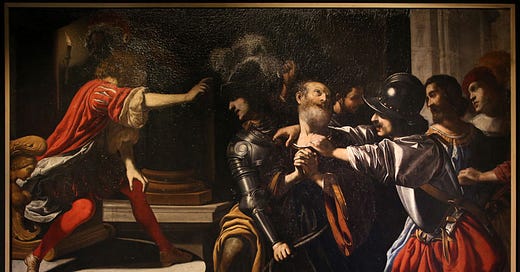There is an extremely interesting story in the Telegraph, though perhaps most readers and even the writer will not realise just why it is so fascinating. It is behind a paywall, so I will summarise it.
Marco Santiela, who is 78, and a businessman from the south of Italy, has been found guilty by a judge in Rome of trying to sell a fake picture, supposedly the work of Picasso. Mr Santiela owns about 50 “Picassos”, which his late father allegedly bought from the artist in the 1950’s. The judge relied on evidence given by several experts who averred that the paintings are fake. Mr Santiela maintains that they are genuine, and has several experts to back him up; he also has, crucially, evidence to show that his father did have contact with Picasso in the 1950’s.
If the paintings and drawings are fake, they are worthless; but if they are genuine, they are worth millions. Mr Santiela will appeal, and try to establish that his pictures are genuine, as one would expect, but…. another way forward presents itself, not that I am for a moment suggesting bad faith on Mr Santiela’s part.
If the pictures are condemned as fake, and worthless, then they become, paradoxically, quite valuable. They can be sold for next to nothing (provided one can get them back from the police who have impounded them) and then, in a few years’ time rehabilitated by a panel of experts who will declare that they are genuine and priceless. So, you could buy the fakes now for £10,000, and sell them afterwards for £100 million, and the difference would be totally legal profit. This is how ‘artwashing’ works, and it is a brilliant way of laundering money.
The first step in such artwashing is to ‘fake’ a genuine picture, and make it nominally valueless as either fake or questionable in some way: a poor copy of an old master, let us say. One can call in a restorer who adds a feature to the painting that is not present in the ‘original’; years later an expert can then come along and declare it to be the real thing, and the windfall in monetary terms launders a huge amount of dirty money. Needless to say the best way of faking a real picture is to have a judge declare it to be fake. Judges are not art critics, so depend on expert witnesses, and they need to be carefully chosen, to make sure they give the right verdict.
This practice of faking genuine pictures is also done to disguise and hide in plain view art that has been stolen. Once again, dodgy restorers can help. Here is a famous case from Italy, reported a year ago by The Guardian:
“Vittorio Sgarbi, a well-known art critic, is also accused of tampering with the painting in order to disguise its origins. Prosecutors said they were investigating Sgarbi for the alleged laundering of stolen art after claims broadcast by Report, an investigative series on the public broadcaster Rai. He denies the allegations. Margherita Buzio, the owner of La Cattura di San Pietro (The Capture of Saint Peter), a painting by the artist Rutilio Manetti, reported the work stolen from her castle in Piedmont in 2013, telling police at the time that the canvas had been cut from its frame. A person identified by Report as a friend of Sgarbi is alleged to have visited the castle a few weeks before to inquire about buying the painting. The painting, which was damaged during the theft, was entrusted to an art restorer for repair a few months later, according to the allegations. The restorer told Report that the artwork he was given was the stolen painting. In 2019, the painting was transferred to another restorer, by which time a candle had been added to the top left corner, allegedly to make it less identifiable. It is unclear who put the candle there, but the painting was the same artwork presented by Sgarbi at an exhibition in Lucca in 2021. Sgarbi has said the painting on show was the original version of The Capture of Saint Peter, which he said he found while restoring an abandoned villa bought by his mother in Viterbo in 2000. He said the painting stolen from the castle was a “bad copy” produced in the 19th century.”
Rutilio Manetti is not a great name in the art world, and the picture is not one I would covet, though it is estimated to be worth 200,000 euro. But still, would you go to all that trouble over the picture? Far more worthwhile is The Nativity with Saint Francis and Saint Lawrence, unaccounted for since the night of 17th October 1969, and whose possible whereabouts inspire my imagination in The Chemist of Catania series. But The Nativity is by Caravaggio, not by his vastly inferior contemporary from Siena, Manetti.
But back to Mr Santiela and the original story. Frankly, I believe Mr Santiela, and I think the judge and his panel of experts are wrong. As the article makes clear, Mr Santiela’s father did know Picasso, and Picasso was extremely prolific, producing hundreds of drawings and paintings for a quick sale to dealers, especially at the end of his career, many of them of low quality, but still, genuine Picassos. As for those who wonder about this ‘businessman’ from a small town in the south of Italy, all I can say is stop your sniggering.





